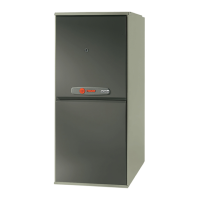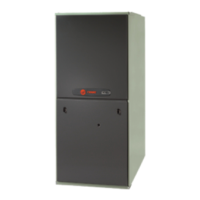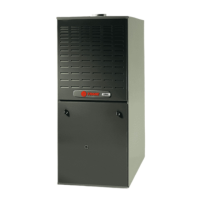18-CD19D5-10 11
Installer’s Guide
GENERAL VENTING
remaining connected to the common venting system
are not in operation:
1. Seal any unused openings in the common venting system.
2. Visually inspect the venting system for proper size and
horizontal pitch and determine there is no blockage or
restriction, leakage, corrosion or other deficiencies which
could cause an unsafe condition.
3. Insofar as is practical, close all building doors and windows
and all doors between the space in which the appliances
remaining connected to the common venting system are
located and other spaces of the building. Turn on clothes
dryers and any appliances not connected to the common
venting system. Turn on any exhaust fans, such as range
hoods and bathroom exhausts, so they will operate at
maximum speed. Do not operate a summer exhaust fan,
close fireplace dampers.
4. Follow the lighting instructions. Place the appliance being
inspected in operation. Adjust thermostat so appliance will
operate continuously.
5. Test for spillage at the draft hood relief opening after
5 minutes of main burner operation. Use the flame of a
match or candle, or smoke from a cigarette, cigar, or pipe.
6. After it has been determined that each appliance remaining
connected to the common venting system properly vents
when tested as outlined above, return door, windows,
exhaust fans, fireplace dampers and any other gas-burning
appliance to their previous conditions of use.
If improper venting is observed during any of the above tests, the
common venting system must be corrected.
Refer to latest edition of National Fuel Gas Code (ANSI 223.1) •
CAN/CGA B149 or Exhibit J of ANSI Z21.47 • CAN/CGA 2.3 for
vent sizing instructions.
VENT FITTING MATERIAL
These fittings are available from your Gas Furnace Distributors.
Straight Pipe Sections, Couplings, 45° Elbows, 60° Elbows, 90° Elbows, Vent or Sanitary Tee, or other necessary fittings may be
2", 2-1/2", 3", or 4" diameter. The allowable materials are shown in Table 6. A vent screen is optional, but recommended. The
vent screen must be 3/8" open mesh weave (minimum 70% open), made of any noncorrosive material having at least 3/8" open
mesh weave.
TABLE 6
PLASTIC PIPE DESIGNATIONS
PVC
ASTM STANDARD PIPE TYPE ALLOWABLE TEMPERATURE MARKING
F891 CELLULAR CORE *158 ASTM F891
D2665 DWV PIPE **158 ASTM D2665
D1785 SCH 40, 80, 120 **158 ASTM D1785
D2241 SDR SERIES **158 ASTM D2241
CPVC
ASTM STANDARD PIPE TYPE ALLOWABLE TEMPERATURE MARKING
D2846 CPVC 41 **212 ASTM D2846
F441 SCH 40, 80 **212 ASTM F441
F442 SDR SERIES **212 ASTM F442
ABS
ASTM STANDARD PIPE TYPE ALLOWABLE TEMPERATURE MARKING
D2661 SCH 40 DWV ***180 ASTM D2661
F628 SCH 40 DWV CELLULAR CORE ***180 ASTM F628
* - Allowable temperatures based on classifications covered in ASTM D4396 [Deflection Temps Under Load (264 PSI)]
** - Allowable temperatures based on classifications covered in ASTM D1784 [Deflection Temps Under Load (264 PSI)]
*** - Allowable temperatures based on classifications covered in ASTM D3965 [Deflection Temps Under Load (264 PSI)]
THIS FURNACE MUST BE VENTED TO THE OUTDOORS.
THESE FURNACES ARE INDUCED DRAFT VENTED AND
MUST NOT BE CONNECTED TO ANY VENT SERVING
ANOTHER APPLIANCE. PLEASE NOTE THAT THESE
FURNACES USE POSITIVE-PRESSURE VENT SYSTEMS.
Proper venting is essential to obtain maximum efficiency from a
condensing furnace. Proper installation of the vent system is
necessary to assure drainage of the condensate and prevent
deterioration of the vent system.
American Gas Association has certified the design of condensing
furnaces for a minimum of 0" clearance from combustible
materials with a single wall plastic vent pipe.
The recommended system is assembled from 2", 2-1/2", 3", or 4"
pipe and fittings. Where the system is routed to the outdoors
through an existing masonry chimney containing flue products
from another gas appliance, or where required by local codes,
then 3" venting of Type 29-4C stainless steel must be used in
place of plastic materials.
These furnaces have been classified as CATEGORY IV furnaces
in accordance with the latest edition of ANSI Z21.47 •
CAN/CGA 2.3 standards. Category IV furnaces operate with
positive vent pressure and with a vent gas temperature less than
140° F. above the dewpoint. These conditions require special
venting systems, which must be gas tight and water tight.
NOTE:
When an existing furnace is removed from a venting system
serving other gas appliances, the venting system is likely to be
too large to properly vent the remaining attached appliances.
The following steps shall be followed with each appli-
ance remaining connected to the common venting
system placed in operation, while the other appliances

